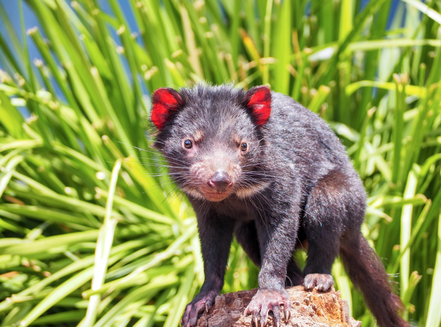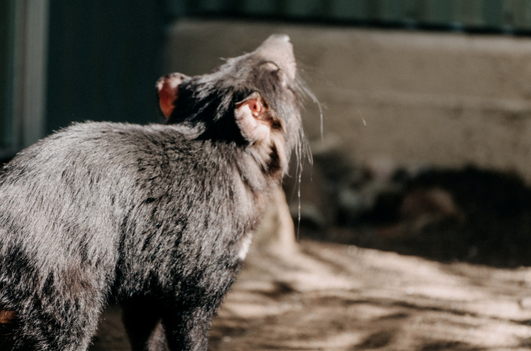 Photo by Kunal Kalra via Unsplash Photo by Kunal Kalra via Unsplash The emblem of the Tasmanian state, the Tasmanian devil (Sarcophilus harrisii), is the largest carnivorous marsupial in the world. It is found on the island of Tasmania, Australia. Fossil evidence suggests that it once occupied the entire Australian mainland some 3,000 years ago. “Devil” was attributed to these animals for their appearance and otherworldly/unearthly screeches at night. These sounds are reflective of fear rather than aggression, however. About the size of the dog, these red-eared devilish creatures can devour medium to large-sized mammals as well as invertebrates with their wide jaws and sharp teeth. However, they serve their ecological role more like scavengers than predators. They feed on carcasses. The nocturnal animal lives in solitary, changing dens every third day of the week, and can travel about 6 miles at night. Threats to SurvivalThis species has faced several threats that limit their population. These include habitat loss, competition for food, and predation. The genetic pool is also small, which means there is low genetic diversity. This is a major concern for the survival of the species. Genetic diversity ensures the survival of the wittiest and fittest individuals; those that can reproduce and continue to increase the population. This is helpful against predators and diseases because greater genetic diversity means greater disease resistance and vice versa. Devil Facial Tumor Disease (DFTD)Devil Facial Tumor Disease (DFTD) is the most devastating threat for Tasmanian devils, causing a rapid decline in the species population almost to the point of extinction. The population has declined by 85%; from 150,000 to 30,000 in the last two decades as the disease is proliferating from east to west. They have been declared endangered by the International Union for the Conservation of Nature (IUCN) in 2009. The disease was first discovered in northeastern Tasmanian devils in 1996 by a wildlife photographer. Devil Facial Tumor Disease (DFTD) is rare infectious Schwann cell type of cancer and 100% fatal. It is transmitted devil-to-devil via biting around the face while displaying aggression; like fighting over a carcass or mating. The disease is most commonly observed in sexually mature individuals. As the name implies, tumors grow on the Tasmanian devil’s face, inside the mouth, or in the oral cavity. The tumors lead to difficulty eating, causing the devil to starve to death within 6 months of infection. No individual of the species has shown any signs of natural immunity. Clones of a Female DevilDr. Elizabeth Murchison, a specialist in oncology and genetics from the University of Cambridge, led research to decode the Tasmanian devil’s genome. They used new DNA sequencing technologies at the Wellcome Trust Sanger Institute. It was discovered that the cancer emerged from a genetic mutation in a single female Tasmanian devil. The DNA from the lesions of the diseased-devil matched the genetic DNA of the founder devil from whom the disease was originally acquired (Murchison et al., 2012). The disease is highly contagious; it metastasized throughout the Tasmanian devil population. She also focused on the origin and somatic evolution of cancer. Though all are clones of a single animal, the genome has acquired mutations and diversified (Murchison et al., 2012). Dr. Murchison has been awarded a 2009 L’Oreal-UNESCO and Ireland For Women in Science Fellowship in recognition of her work on the origin and evolution of transmissible cancer. This infectious cancer is one of the three rare natural occurrences in which the living cancer cells are physically transferred from one organism to another. The other two affect dogs (the canine transmissible venereal tumor CTVT) and clams (disseminated neoplasia). The disease has successfully propagated throughout the population for two reasons; low expression of MCH-I and diminished genetic diversity (Kosack et al., 2019). Low Expression of MCH-IUsually, when the body recognizes foreign agents, a natural immune response is triggered. The MCH-I (major Histocompatibility complex class-1) proteins on the surface of healthy cells recognize the incoming stressor as native or invasive. It then initiates a defensive response that fights off the invasive agents. In the case of DFTD, the lack of anti-tumor immunity is attributed to an absence of MHC-I molecule expression. Once acquired, cancer flourishes as the disease feeds off the animal like a parasite and they die without evidence of antibody or immune cell response within months (Tovar et al., 2017). In another research study, scientists discovered the over-expression of cell surface receptor proteins: ERBB receptors. In DFTD, these proteins bind with the signaling molecules outside of cells and initiate the processes inside the cell which activate STAT3 protein that in turn activates genes involved in metastasis (Kosack et al., 2019). Therefore, by inhibiting the activation of ERBB receptors or STAT3 proteins, the cancer cells enter an arrested state. Furthermore, the MCH-I response was reestablished after initiating a defensive response. Scientists have been able to induce the expressions of MCH-I proteins on the surface of cancer cells in Tasmanian devils. The DFTD cancerous cells possess the genetic machinery to produce and express the proteins. There are uncertainties in this research because of the small-sized population of the endangered species.
|
|
|
(833) CMS-LINE
(833) 267-5463 PO Box 13477 Mill Creek, Wa, 98082 © Conservation Made Simple. All rights reserved.
501(c)(3) Non-Profit, Tax ID#: 82-1646340 Copyright © 2021 Conservation Made Simple |

